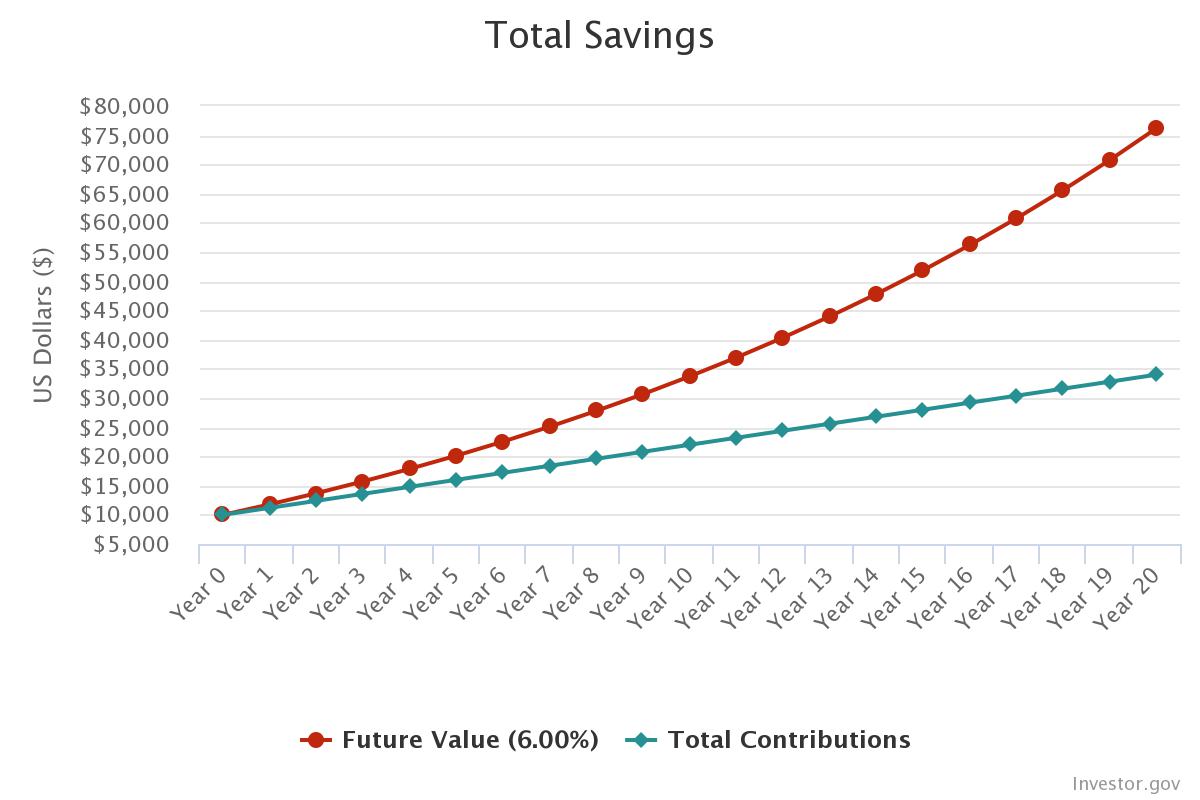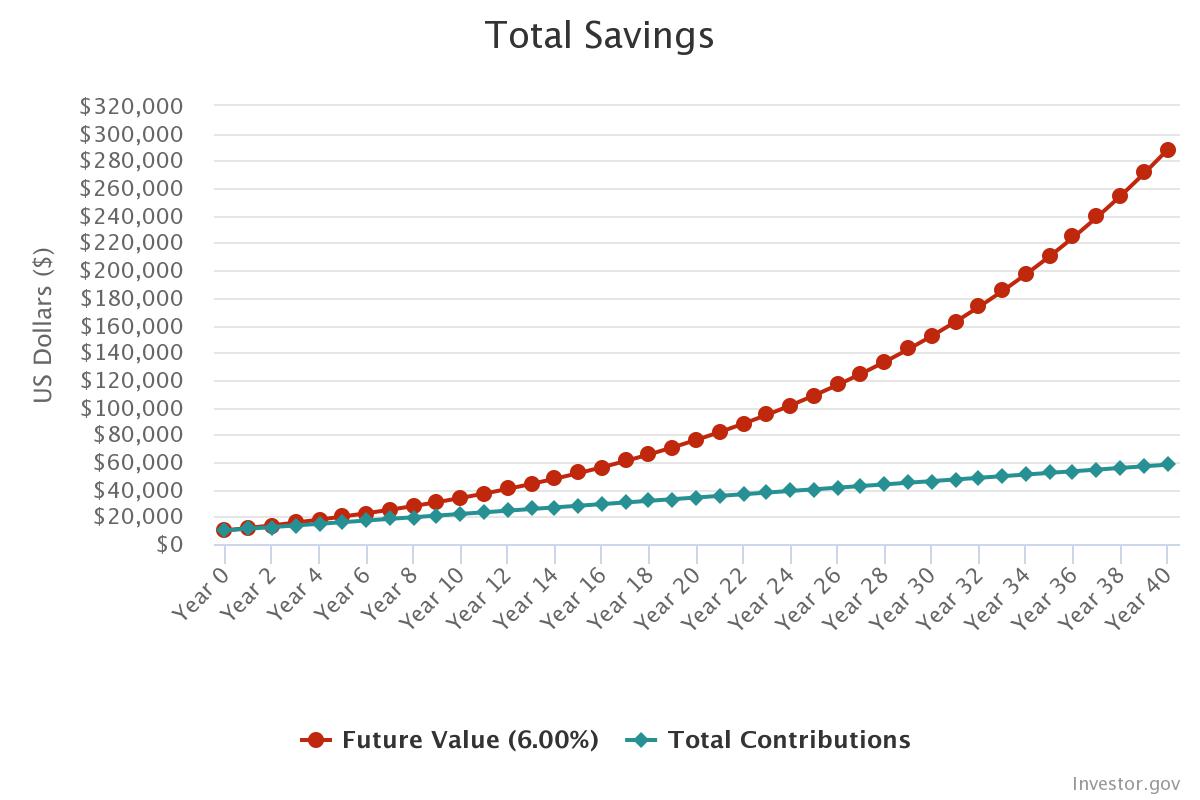Retirement saving is one of the most important financial decisions you will make as it secures a comfortable retirement. No matter your age or income level, it is important to start saving for retirement as soon as possible if you have not started yet. Even if you have a small income and living on a tight budget, you can still boost retirement savings with these 10 effective retirement savings tips I am about to show you.
Whether you want to start saving for retirement or boost your retirement savings, you have come to the right place. In this article, I will give you 10 practical retirement savings tips that will help you grow your nest egg fast.
Do not ignore compound interest
The best time to start saving for retirement was yesterday. The next best time to start saving for retirement is today. Waiting any longer robes you the chance to build generational wealth with less stress and reach financial independence. When saving for retirement and investing your hard-earned wages for the long term, compound interest makes all the difference.
Compound interest is the ultimate secret of retirement savings and growing wealth. To take full advantage of compounding interest, however, you will need to start early. Every dollar you allocate toward retirement savings gets compounded and helps you grow your account faster.
The secret to retirement savings is not about how much you save. Instead, it is about how much you earn from your retirement savings and the tax benefits you get. That is why to boost your retirement savings, you need to focus on investment vehicles that generate more cash flow and reduce your tax liability at the same time.
If you are ready to take your retirement savings to the next level, here are my favorite 10 practical tips to boost your retirement savings.
1. Know your retirement savings goals
The first and most important step in increasing retirement savings is to know how much you need to retire. This will allow you to break down your retirement savings strategies and allocate funds to different investment securities that meet your specific retirement saving goals.
The amount you need to retire will depend on the lifestyle you will have and your life expectancy. It is also important that you know the age at which you want to retire. For example, a person who is planning to retire at 60, will need more savings than someone who is planning to retire at 75. This is because early retirement equates to more years without working. Hence, requiring more savings and more passive income.
The most popular retirement withdrawal formula is the rule of 4%. This rule suggests that you can withdraw 4% of your retirement savings every year and live comfortably for 30 years. For example, if you have saved $1,200,000 toward retirement and withdraw 4% every year, you will be able to fund 30 years in retirement adjusted to inflation.
This formula does not include retirement earnings such as passive income from other sources such as capital gains, rental income, interest payment, and loyalty.
Related: How much do I need to retire: Save for retirement
2. Start now
Some people confuse retirement savings and investing. Retirement savings is completely different from investing but both follow the same principles.
Investing is an essential step you must take to grow your retirement savings accounts. Also, you must start saving for retirement as soon as possible. This is because when you start early, you get to invest your money and take full advantage of compounding interest. Compound interest allows you to earn interest on earnings and principal at the same time.
By reinvesting your earnings over some time, your portfolio grows exponentially.
Take a look at the following hypothetical example of the effect of compounding interest on your retirement savings.
Example of compounding interest on your retirement savings account
Let’s assume that you started saving for retirement when you were 45 years old with an initial savings amount of $10,000. In addition, you contributed $100 every month. That is $50 per paycheck or every two weeks for a bi-weekly pay period. We can also assume a 6% return on investment(ROI) and all earnings are being reinvested. How much will you have in your retirement savings account when you retire at 65? Let’s see how compounding interest will boost your retirement savings in only 20 years.

After 20 years, your retirement savings account will reflect the following numbers.
- Total contribution = $34,000
- Total portfolio value = $76,214.06
This is more than $42,000 in profit. Your profit is more than your total contributions. That is how compound interest works.
What if you started saving when you were 25 instead of 45? That is a 20-year difference. What will your retirement account look like when you turn 65?

You can see that by starting early, the compounding effect boosts your retirement savings higher than when you started late. By starting at 25, your account value reflects the following numbers when you turn 65.
- Total contribution = $58,000
- Total account value = $288,571.54
There is a huge difference between both retirement accounts. You can see that compound interest is more effective when you start saving for retirement early.
If you want to boost your retirement savings with less stress, start saving early. The secret here is not how much you save. Instead, it is how long you stay invested that allows compound interest to do its things.
When should you start saving for retirement? The answer is now if you did not start yesterday.
3. Take advantage of your employer-sponsored retirement plans
One of the best ways to boost your retirement savings is to make contributions to employer-sponsored plans such as pre-tax 401(k) plans. For example, if your employer offers a pre-tax 401(k) and you are eligible, you can start contributing to the plan right away.
Any amount you contribute to your pre-tax 401(k) will come from your before-tax wages. This plan gives you upfront tax benefits and allows you to grow your retirement savings on a tax-deferred basis and only pay income tax when you are withdrawing the money during retirement.
For 2024, you can contribute up to $23,000 or $30,500 if you are 50 or older. So, if you are in a higher tax bracket, contributions to your pre-tax 401(k) plan might put you in a lower tax bracket.
4. Take advantage of the employer match
One of the greatest ways to boost your retirement savings is to take advantage of an employer match to the plan. Some employers match employees’ contributions up to a certain percentage. Any employer match to your account is free money, and therefore, you should not leave it on the table. If you cannot afford to max out your 401(k) plan, at least contribute up to your employer match percentage.
For example, if your employer matches your contributions up to 6% of your gross income, make sure you allocate at least 6% of your gross income toward your 401(k) plan. It is free money. So, take it. 6% of your gross income will automatically boost your retirement savings very fast without doing extra work.
5. Open an individual retirement account (IRA)
Whether you have a 401(k) plan with your current employer or not, you should always have an individual treatment account (IRA). This account allows you to save more money toward retirement with added tax incentives.
You can either open a traditional IRA or a Roth IRA. Contributions to your Roth IRA will come from your after-tax wages. However, you will grow your account tax-free, and qualified distributions will not be taxed during retirement. Any money you contribute to your traditional IRA, on the other hand, may be tax-deductible. It will all depend on your filing status and traditional IRA income limits.
Are you not sure if your traditional IRA will be tax-deductible in 2024? Check out this guide to traditional IRA income phase-out ranges to check your eligibility for tax deduction in 2024.
The contribution limits to an IRA in 2024 are $7,000 or $8,000 if you are 50 or older. If you are looking for flexible ways to increase retirement savings fast, opening an IRA will be a smart move. Do you have an IRA with a different institution that you want to transfer or roll over to Fidelity? Check out this guide on how to transfer a traditional IRA to a Fidelity traditional IRA.
Related articles:
- Opening a spousal IRA in 9 simple steps
- Opening a Roth IRA in 6 simple steps
- Custodial IRA: Can a minor open a Roth IRA?
6. Take advantage of catch-up contributions
A big mistake many people make is to assume that they have a lot of time. So, they delay saving for retirement and choose to make inadequate contributions which prevents them from maximizing all retirement saving benefits. If you are one of the people who started a little late, the IRS has catch-up contributions for people who are 50 or older.
Most retirement plans come with catch-up contributions. Here are catch-up contributions to popular retirement accounts.
- Roth 401(k) and traditional 401(k) for 2024 is $7,500
- SIMPLE IRA and SIMPLE 401(k) for 2024 are $3,000
- Traditional IRA and Roth IRA for 2024 is $1,000
- HSA catch-up contribution is $1,000
By taking advantage of these catch-up contributions depending on the account you have, you can easily boost your retirement savings. The more you contribute to retirement accounts, the faster you increase your savings and the more tax benefits you get.
You might also like: 6 Roth 401(k) benefits you did not know about
7. Take advantage of your Health Savings Account(HSA)
A Health Savings Account (HSA) comes in handy when you have a lot of medical-related expenses. The HSA is part of some companies’ medical benefits packages. To qualify for an HSA, you must be enrolled in a High Deductible Health Plan(HDHP) with your employer.
If you have an HDHP with your employer, you can then contribute to your HSA up to the maximum allowed. For 2024, you can contribute up to $4,150 for self-only and $8,300 for families to your HSA.
Why is it important to contribute to your HSA account?
While the money in your HSA can only be used for qualified medical-related expenses, the HSA can help you boost your retirement savings.
Once you reach the investment threshold you established in your HSA, you can invest the money in your account. This strategy allows you to grow your account on a tax-deferred basis. You will have the option to choose automatic or manual investments. By default, your HSA will not come with investment options. So, before you start investing the money in your HSA, you must first enroll in the HSA investment option.
The money you contribute to an HSA is designed for medical-related expenses. However, if you don’t spend all that money, you can invest and withdraw it for any expenses of your choice without a penalty once you reach 65. When your withdrawals from HSA are not designed for qualified medical expenses, you will pay income tax. A 20% penalty will also apply if you are under 65, according to the Michigan Civil Service Commission.
8. Reduce your expenses
If you are finding it difficult to boost your retirement savings, it is more likely that your current lifestyle does not allow you to save. You are spending every dollar you make.
You can easily boost your retirement savings account by reducing your expenses. An effective way to reduce your expenses is to establish a budget that allows you to save more money. Look at all your expenses and eliminate some of your wants such as expensive movie subscriptions, daily shopping, designer clothes, etc.
You might also need to change your financial habits such as eating out every day, gambling, smoking, drinking, or buying brand-name products.
Every dollar you save in this process can help you increase your retirement savings.
Related: 9 things you must do before you create a personal budget
9. Avoid questionable debts
A common financial mistake millions of people make is accumulating a lot of debt. Debt is not bad if you use it correctly. However, if you borrow money so that you can go shopping, then you are playing with fire.
According to Shiftprocessing, 80% of Americans have consumer debt. Among the top debt per household, mortgage debts come on top with $189,586 on average, followed by student loans at $46,822, car loans at $27,804, personal loans at 10,000, and credit card debts at $5,135 on average.
If you are one of these people who are finding it difficult to pay off their debts, paying off your debts should be a top priority. However, if you have not accumulated too much debt already, avoid questionable debts.
To boost your retirement savings, you must stay away from questionable debts such as consumer debts and personal loans. These debts do not help you achieve anything that brings you value or financial stability. In addition, they come with relatively higher annual percentage rates (APRs) compared to regular loans such as mortgages.
Debt prevents you from contributing more money toward retirement as every dollar you make is spent to pay off credit card debts, car loans, mortgages, student loans, etc. You can’t get ahead financially if everything you are making goes directly to the lender.
Rule of thumb: Do not borrow if you don’t have to and never borrow more than you can afford to pay off. If you cannot buy something with cash, do not borrow to buy it. It simply means that you cannot afford it.
10. Automate your savings
The final tip to boost your retirement savings is to automate your savings. We live in a busy world with a lot of moving parts. Sometimes we think that everything is under control whereas the opposite is true.
There are times when you will forget to submit your monthly contributions or forget that those accounts exist in the first place. When this happens, you will find it difficult to reach your retirement savings goals.
To avoid missing a contribution to your retirement savings account, automate your retirement savings. Decide how much you want to put in each retirement account every month or every pay period and let technology take care of the rest.
If you choose to automate your savings, make sure that you have enough funds in the bank account where the money will come from. You don’t want to pay overdraft fees for no reason.
More saving tips
7 money accounts everyone should have in 2022
8 reasons why poor people stay poor







